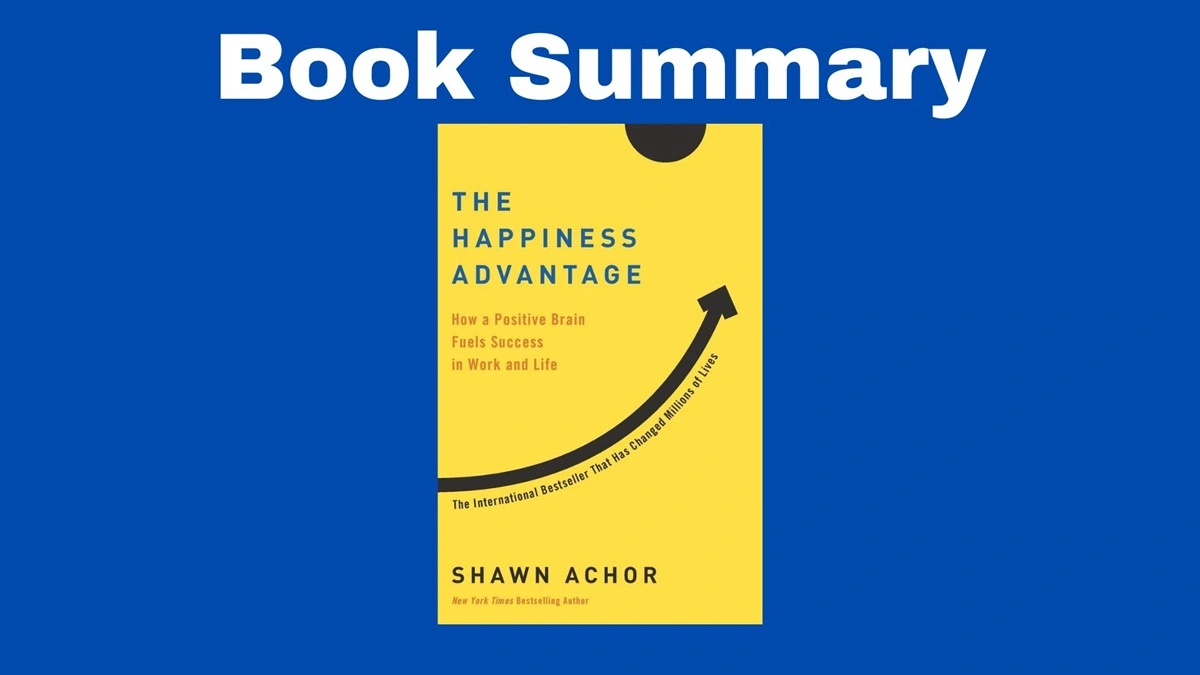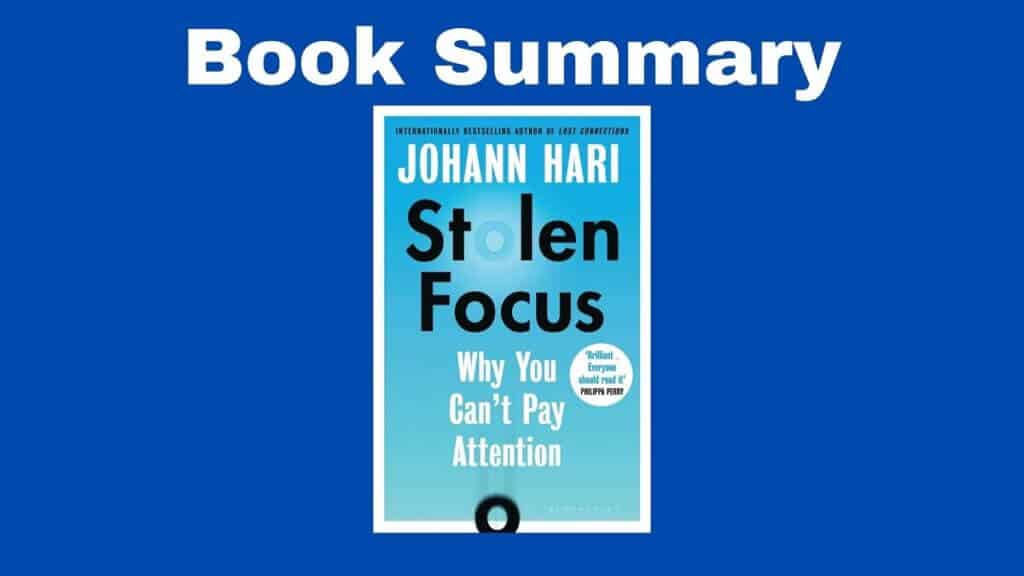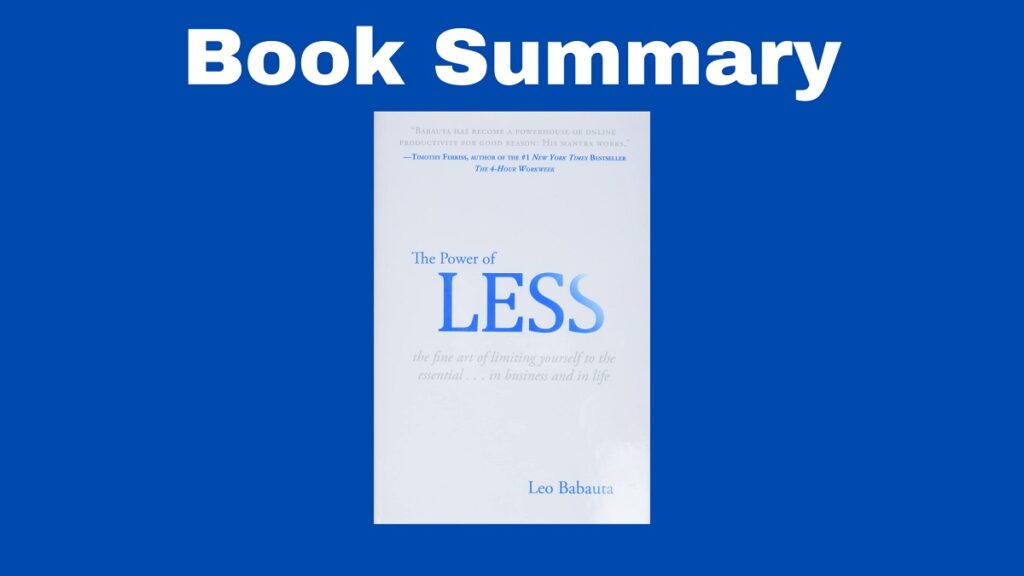The Book in Three Sentences
In this summary of The Happiness Advantage, you’ll learn that happiness is the realization that we can change. Popular belief tells us that once we succeed, we’ll be happy, but science reveals that it’s the other way around. In the book, Shawn Anchor teaches us a series of strategies and habits that will make us happier at work, at home, and in life.
The Happiness Advantage Summary
Part I: Positive Psychology at Work
Introduction
Everyone follows the same formula: work hard, achieve success, and then you’ll be happy. This motivates us in life, but it also makes happiness impossible unless we achieve success first. The problem with this approach is that as we become more successful, we move the goalpost further and further out. Before we know it, happiness becomes unreachable. The formula shouldn’t be “success then happiness”, but the other way around. When you put happiness and optimism first, it gives us a competitive edge, something the author calls the Happiness Advantage.
Discovering the Happiness Advantage
Our interpretation of reality changes our experience. When you focus on stress and pressure, you’ll miss the opportunities in front of you. When you develop a positive mindset, on the other hand, you’ll thrive. As humans, we’re wired to focus on the negative, but doing that for too long becomes a self-fulfilling prophecy. The formal education system teaches us a lot, but one thing it doesn’t teach us is how to be happy. This explains why some smart people never achieve it. In a way, they’ve sacrificed happiness for success which means they believed the formula they’ve been taught. The opposite is also true and we become more successful when we’re positive and happy. Our brains have a natural predisposition to perform at their best when they’re positive. Ironically, when we sacrifice happiness for success, we immediately lower our chances of ever achieving it.
The author found seven patterns that predict achievement:
- The Happiness Advantage: this principle is about retraining your brain to be more positive which will boost your productivity and performance.
- The Fulcrum and the Lever: this principle is about adjusting our mindset. Once we’ve done that, we’ll get the power that leads to success.
- The Tetris Effect: this principle helps us retrain our brain to find opportunities around us.
- Falling Up: this principle is about finding the path that leads us out of failure.
- The Zorro Circle: this principle is about regaining control of our emotions by focusing on small and manageable goals.
- The 20-Second Rule: this principle helps you make small energy adjustments to replace bad habits with good ones.
- Social Investment: this principle is about investing in a social support group to achieve success.
The Happiness Advantage at Work
We assume that people are so upset and confused that the last thing they want is to learn from positive psychology. Nevertheless, they need it more than ever. To make sure that the framework works, the author used the principles of the Happiness Advantage on some of the biggest financial institutions as they were going through problems and the results couldn’t have been more positive. Soon, Anchor applied the principles to every profession to prove that they work.
Change Is Possible
We believe that our potential is biologically fixed, but we can change thanks to something called neuroplasticity. This is our brain’s ability to grow and adapt to new circumstances. The way this works is that our behavior changes our brain, so the more we practice something, the more it affects our brain. The Happiness Advantage helps us capitalize on our brain’s ability to change.
Part 2: The Seven Principles
Principle #1: The Happiness Advantage
For decades, we believed happiness was the result of success, but thanks to positive psychology, now we know the opposite is true. No one has a definitive answer to the question “What does happiness mean?” This is the case because everyone experiences happiness differently. Scientists define happiness as the experience of positive emotions (a combination of pleasure with feelings of purpose). For Aristotle, happiness was Eudaimonia which roughly translates to “human flourishing”. Apart from referring to good feelings, happiness is also an important ingredient to our success. Happiness leads to success in every area of our lives and more specifically in our careers.
Focusing on something happy before a stressful situation leads to the undoing effect. This gives you a burst of positive emotions and protects you from stress. Examples of activities you can engage in to boost your happiness include:
- Meditation
- Finding something to look forward to
- Performing acts of kindness
- Creating a positive environment
- Exercising
- Spending money on experiences (such as concerts or dinners)
- Doing something you’re good at
Principle #2: The Fulcrum and the Lever
Our brain has limited resources to experience the world. The brain has two options: it can focus on pain, negativity, stress, and uncertainty, or it can focus on gratitude, hope, resilience, optimism, and meaning. While we can’t change reality, we can change how we perceive it. Like Archimedes, we can find a lever long enough and a place to stand and we can move the world. The lever is our potential and the fulcrum is our mindset.
How you frame the activities you do determines the quality of the results you’ll get. If you see something as a “waste of time”, you won’t get much out of it, but if you see it as something fulfilling, you’ll enjoy it and be more productive. Similarly, when you think you will succeed, you have more chances of that happening. This doesn’t mean you should ignore your weaknesses, but you should focus on your strengths instead.
As valuable as believing in your skills is, believing you can improve them is even more important. Stanford psychologist Carol Dweck proved that people can be classified into two groups: those with a fixed mindset believe their skills are set and those with a growth mindset believe they can improve their qualities through effort. People with fixed mindsets underperform and miss opportunities to improve. Those with a growth mindset improve their abilities constantly and have more chances of succeeding. Beliefs dictate our actions. How you perceive your job, for instance, determines your satisfaction, sense of fulfillment, and how well you’ll be at it. Ultimately, the kind of job you do isn’t important as long as you perceive it as something bigger than yourself.
Likewise, what we communicate to others has a powerful effect on their performance. When we believe in someone else’s potential and that potential is realized, this is known as the Pygmalion effect.
Principle #3: The Tetris Effect
Our brains are programmed to follow patterns. Playing a video game like Tetris for an extended period creates a cognitive pattern where you involuntarily see shapes wherever you go. This happens because playing a game for hours creates new neural connections that affect how you see the real world.
Although the Tetris Effect often happens when someone plays games, we all know someone who can’t break a pattern of thinking or behaving. This often manifests in the form of complaining, focusing on the negative, predicting doom, and so on. People don’t do this on purpose. It’s just that their brains are stuck on a pattern they’ve been practicing for years. Luckily, we can train our brains to focus on the positive things and capitalize on the Happiness Advantage.
It’s worth pointing out that people whose jobs require them to find errors are more likely to carry that pattern wherever they go. Focusing on the negative sides of things causes problems outside of work. For example, lawyers are more likely to argue with people, athletes tend to compete with friends, and social workers often distrust men. This leads to a negative Tetris Effect, a cognitive pattern that decreases our chances of success.
Luckily, the Tetris Effect also works to scan the positive things around us. Before we can find those things though, we must look for them. Unless we’re constantly looking for the positive side of things, we might miss them, something psychologists refer to as innatentional blindness. This also explains how two people can look at the same experience and interpret them differently. We want to reprogram our brains to always find opportunities. Doing so leads to happiness, gratitude, and optimism. When you expect a favorable outcome, your brain is more likely to find one. This is called predictive encoding.
The best way to build the positive Tetris Effect is through practice. Writing experiences you’re grateful for regularly is a great way to do this, for example. There is such a thing as irrational optimism which blinds us to problems, so the idea isn’t to ignore the bad things completely but to have a healthy degree of optimism.
Principle #4: Falling Up
When you take an action, your brain often creates a mental map with different paths. It then tries to predict where those paths lead. When we face a moment of crisis, there are three possible paths: one where you end where you started, one where you end up worse than when you started, and a Third Path that leaves us stronger and more capable. The last one is the path up. When you see failure as an opportunity, you’re more likely to experience growth. We all experience setbacks from time to time and how you see them makes all the difference. Will you see it as an obstacle or as a stepping stone to something better? As counterintuitive as it sounds, you should celebrate failure because that’s the best way to learn important lessons. To accelerate learning, fail early and often.
One of the reasons why people don’t look for the Third Path is because they have embraced a sense of helplessness. When we’re convinced our actions are futile, we believe we can’t do anything to revert a situation. In other words, we eliminate the path up.
Turning adversity into opportunity is a skill and as such, anyone can learn it. To go from adversity to opportunity, the author uses the ABCD model which stands for Adversity, Belief, Consequence, and Disputation. Adversity is the event. Belief is our reaction to it. Seeing it as an opportunity for growth often leads to a positive Consequence. Finally, Disputation involves challenging the belief. If the adversity we’re facing is bad, we should use the method known as decatastrophizing. When we do this, we try to see the adversity as something real, but not as a catastrophe.
Principle #5: The Zorro Circle
According to the legend, a masked hero roamed the southwestern region of the United States helping people. Before he became Zorro, the hero was passionate and inexperienced, so he trained for hours on end. At first, he only fought inside a small circle, but little by little, he expanded the circle which allowed him to become the legendary swordsman everyone remembers.
To become masters of our circle, we must concentrate on small, manageable goals. This is how we expand the circle and get more resources, knowledge, and confidence. The feeling of control over our lives leads to happiness. To be clear, how much control we have isn’t important. How much control we think we have is. The internal locus of control is the belief that our actions impact our outcomes.
We can divide our brain into two parts: the emotional system and the rational system. The emotional system allowed us to survive by triggering a fight-or-flight response whenever there were dangers around us. The rational system lets us think logically, using evidence to come up with plans for the future. Most of the time rely on the rational system, but when we’re exposed to too much stress, the emotional system takes over.
To reclaim control from the emotional system and give it to the rational system, we need the Zorro Circle. First, we need self-awareness by putting our feelings into words. Verbalizing the stress you feel gets you closer to regaining control. Then you need to see which variables are under your control and which ones aren’t. The idea is to focus on the things you control because this is where you see a relationship between your actions and your outcomes. By doing so, you’ll slowly expand your circle. The important part is to take small steps consistently.
Principle #6: The 20-Second Rule
Some aspects of life are common sense, but that doesn’t make doing them any easier. Knowledge is important, but without action, it means nothing. That’s the case because action is the hardest part when it comes to good habits. Habits are automatic behaviors that play an important role in our lives. The more we repeat certain actions, the easier it is to carry them out. This is how habits are formed. You do an activity for the first time and it demands time and effort, but the more you do it, the easier it gets.
To start new habits (or break bad ones), the solution isn’t to rely on willpower because we have a limited supply of it. The best way to engage in healthy habits is to make them easy to do. This is why default options are so powerful. Changing them demands time and effort from the user and as a consequence, a lot of times they won’t. We need to be aware of this because it shapes our choices and behaviors.
This is also the case in the workplace where it’s easy to be tempted by distractions, such as news websites, social media, or email. The problem is that you lose your concentration every time you welcome a distraction and recovering from it takes several minutes. Not only do we have access to endless distractions, but the ease with which we can get them.
For this purpose, the author came up with the 20-second rule. When the thing we want to use is 20 seconds away, it’s less likely that we’re going to use it. In other words, we want to put the object that helps us do the habit we want in the path of least resistance. Likewise, you can break bad habits by placing the object far away from you and making it difficult to get it. When it comes to bad habits, adding 20 seconds to your day can give you back a few hours.
These barriers we create between ourselves and our vices make a big difference. As counterintuitive as it sounds, the 20-second rule encourages to save time by adding time. Examples of this technique include disabling automatic login for social media accounts. Similarly, setting rules in advance helps us know how to behave in the future without having to make a decision on the spot and waste our precious willpower.
Principle #7: Social Investment
The best way to face unexpected challenges is with other people. This is true in the workplace, but also in life. Social support is one of the most valuable resources we have. In moments of crisis, it’s easy to retreat into ourselves, but that’s when we need to reach out to other people the most. In the Happiness Advantage, the best investment you can make is social relationships. To make big challenges more bearable, you need good relationships because they protect you from stress.
Part 3: The Ripple Effect
Spreading the Happiness Advantage at Work, at Home, and Beyond
The Happiness Advantage is important because once you put the seven principles into practice, it has ripple effects. This means it impacts us, as well as those around us. This is the case because we have something called mirror neurons, brain cells that can sense someone else’s feelings. When someone smiles, we tend to smile back and when someone gets hurt, we feel their pain. This isn’t just true for physical sensations, but emotions too. Our happiness is contagious and so is our negativity. To create a butterfly effect of positivity that has massive results, start small. After all, tiny changes can lead to great results.
Further Reading
If you enjoyed this book summary of The Happiness Advantage, you might also like the following articles:




